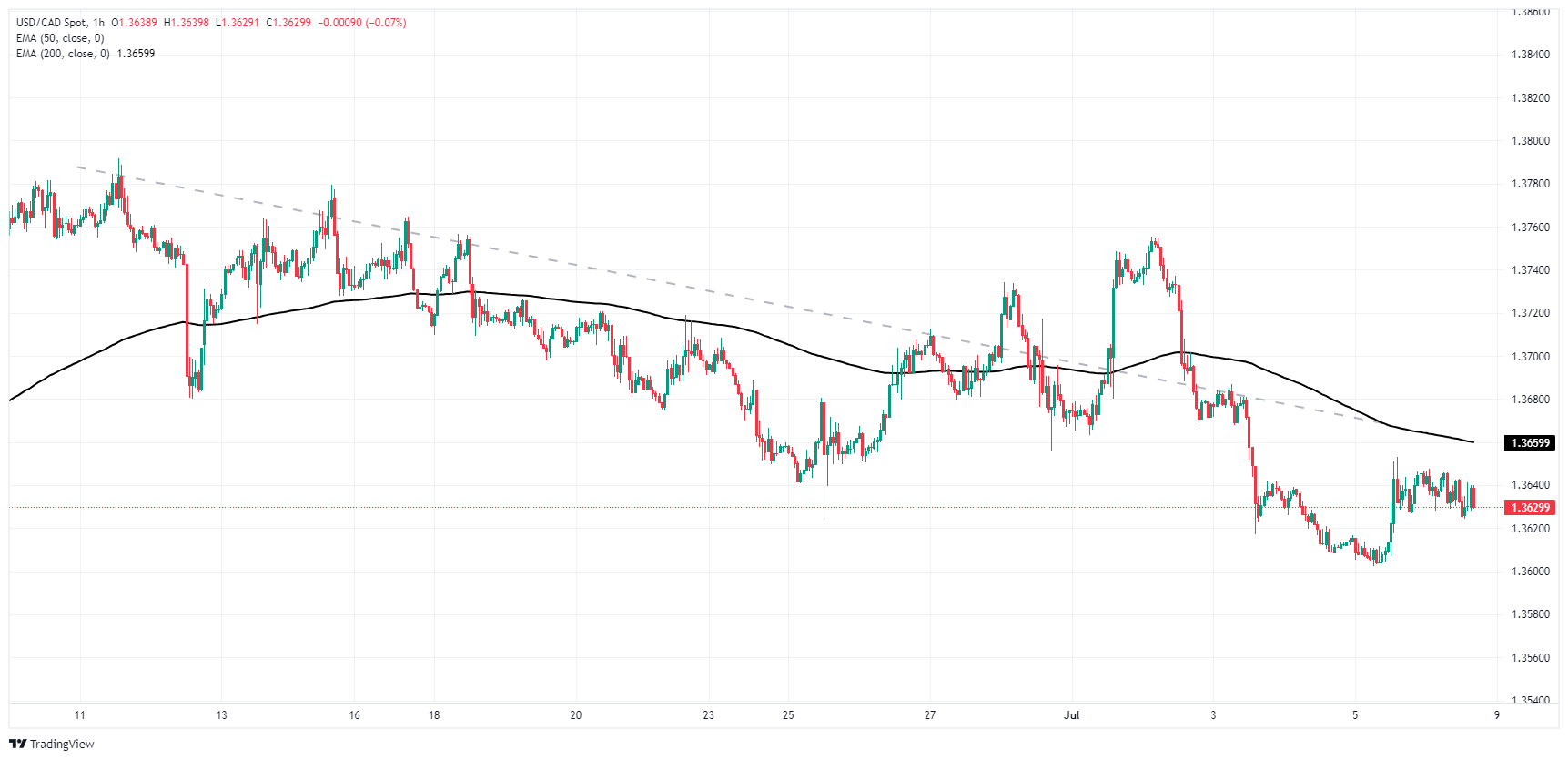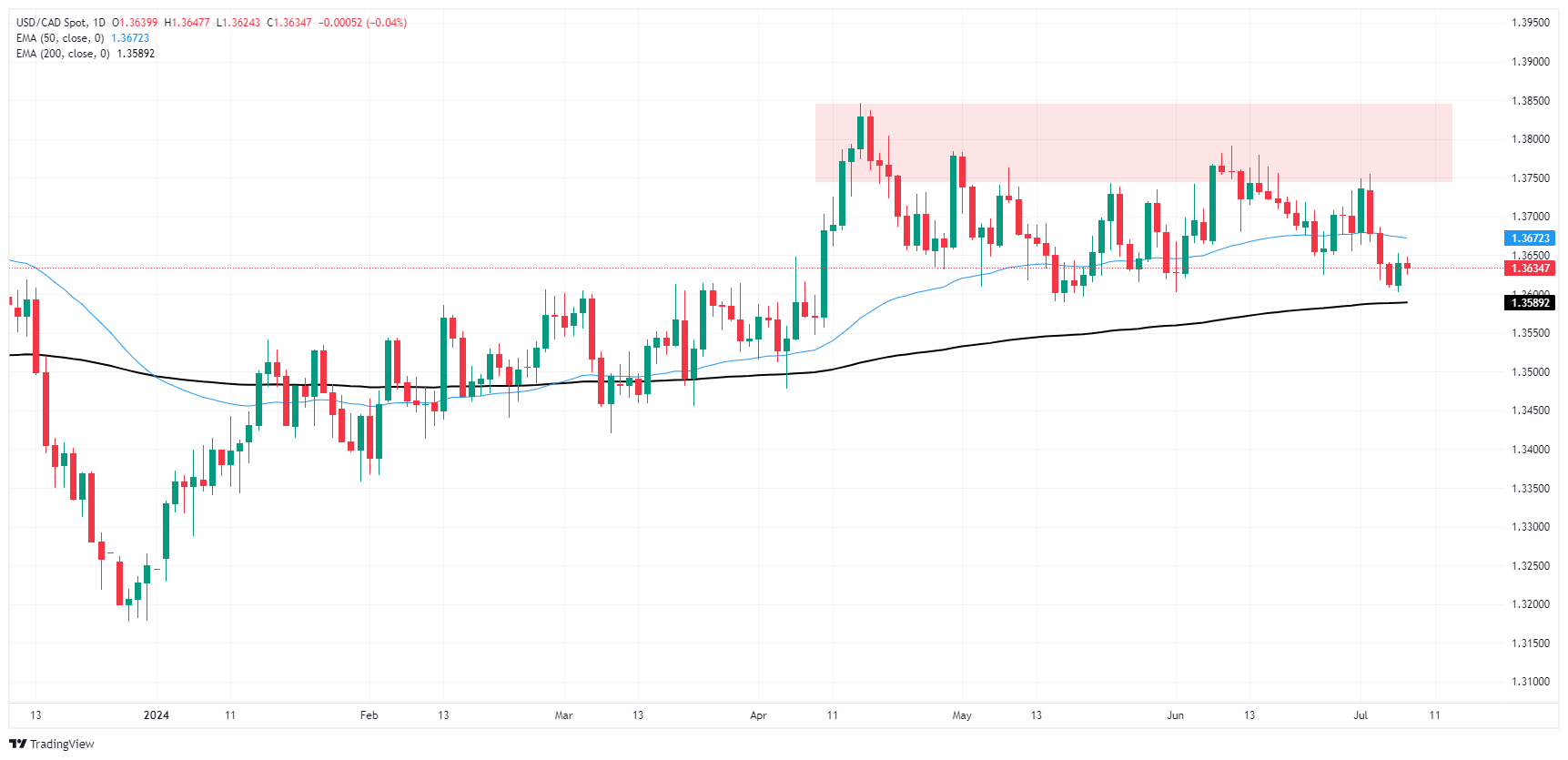- Аналітика
- Новини та інструменти
- Новини ринків
- Canadian Dollar kicks off the week with a lazy Monday fizzle
Canadian Dollar kicks off the week with a lazy Monday fizzle
- Canadian Dollar flows mostly stuck in place on Monday, limiting price momentum.
- Canada has a strictly low-tier showing on the economic calendar this week.
- Markets to keep an eye out for Fed Chair Powell’s Monetary Policy Report.
The Canadian Dollar (CAD) largely churned in familiar territory on Monday, trading softly against the US Dollar (USD) as markets recovered from last Friday’s US jobs data glut. Monday’s sun rises on calmer markets after US labor figures crimped recent gains for the CAD, and USD/CAD is marking out a thin range just below 1.3650.
Canada is almost entirely absent from the economic calendar this week, leaving the CAD adrift against broader market flows. Key US inflation and activity data are due throughout the week, and market participants will be trying to nail down firmer timing on the Federal Reserve’s (Fed) pace of rate cuts moving forward.
Daily digest market movers: Canadian Dollar mostly treads water in Monday kickoff
- Key CAD data is absent this week; CAD traders are forced to wait for the crumbs of Friday’s low-tier Building Permits.
- North American markets will remain tepid until Tuesday’s first of two appearances from Fed Chairman Jerome Powell, who will deliver his two-day Semi-Annual Monetary Policy Report to the US Senate Banking Committee.
- A smattering of appearances from other Fed policymakers are due throughout the first half of the trading week.
- US Consumer Price Index (CPI) inflation is slated for Thursday, with Producer Price Index (PPI) inflation due on Friday.
- Investors will be looking for a further easing in US inflation data to help muscle the Fed closer to a rate cut in September.
Canadian Dollar PRICE Today
The table below shows the percentage change of Canadian Dollar (CAD) against listed major currencies today. Canadian Dollar was the strongest against the Australian Dollar.
| USD | EUR | GBP | JPY | CAD | AUD | NZD | CHF | |
|---|---|---|---|---|---|---|---|---|
| USD | 0.06% | -0.05% | -0.02% | -0.09% | 0.16% | 0.07% | 0.09% | |
| EUR | -0.06% | 0.09% | 0.24% | 0.17% | 0.26% | 0.34% | 0.37% | |
| GBP | 0.05% | -0.09% | 0.10% | 0.09% | 0.16% | 0.25% | 0.27% | |
| JPY | 0.02% | -0.24% | -0.10% | -0.07% | 0.19% | 0.24% | 0.17% | |
| CAD | 0.09% | -0.17% | -0.09% | 0.07% | 0.20% | 0.16% | 0.20% | |
| AUD | -0.16% | -0.26% | -0.16% | -0.19% | -0.20% | 0.09% | 0.10% | |
| NZD | -0.07% | -0.34% | -0.25% | -0.24% | -0.16% | -0.09% | 0.03% | |
| CHF | -0.09% | -0.37% | -0.27% | -0.17% | -0.20% | -0.10% | -0.03% |
The heat map shows percentage changes of major currencies against each other. The base currency is picked from the left column, while the quote currency is picked from the top row. For example, if you pick the Canadian Dollar from the left column and move along the horizontal line to the US Dollar, the percentage change displayed in the box will represent CAD (base)/USD (quote).
Technical analysis: Canadian Dollar spins in place on tepid Monday
The Canadian Dollar (CAD) eased to broadly higher territory on Monday as market focus shifted elsewhere, leaving the CAD to drift in familiar territory. The Canadian Dollar rose around one-quarter of one percent against the New Zealand Dollar (NZD) and the Swiss Franc (CHF), but is trading flatly elsewhere, trading within one-tenth of one percent against the US Dollar, Euro (EUR), Pound Sterling (GBP), and Japanese Yen (JPY).
Last Friday’s NFP-fueled bounce in USD/CAD has run aground of low-volume rocks, and the pair’s recovery from just north of 1.3600 remains within arm’s reach of fresh lows. Further downside is still on the cards if Greenback bulls cannot muscle the pair back above the 200-hour Exponential Moving Average (EMA) at 1.3660.
USD/CAD hourly chart
USD/CAD daily chart
Canadian Dollar FAQs
The key factors driving the Canadian Dollar (CAD) are the level of interest rates set by the Bank of Canada (BoC), the price of Oil, Canada’s largest export, the health of its economy, inflation and the Trade Balance, which is the difference between the value of Canada’s exports versus its imports. Other factors include market sentiment – whether investors are taking on more risky assets (risk-on) or seeking safe-havens (risk-off) – with risk-on being CAD-positive. As its largest trading partner, the health of the US economy is also a key factor influencing the Canadian Dollar.
The Bank of Canada (BoC) has a significant influence on the Canadian Dollar by setting the level of interest rates that banks can lend to one another. This influences the level of interest rates for everyone. The main goal of the BoC is to maintain inflation at 1-3% by adjusting interest rates up or down. Relatively higher interest rates tend to be positive for the CAD. The Bank of Canada can also use quantitative easing and tightening to influence credit conditions, with the former CAD-negative and the latter CAD-positive.
The price of Oil is a key factor impacting the value of the Canadian Dollar. Petroleum is Canada’s biggest export, so Oil price tends to have an immediate impact on the CAD value. Generally, if Oil price rises CAD also goes up, as aggregate demand for the currency increases. The opposite is the case if the price of Oil falls. Higher Oil prices also tend to result in a greater likelihood of a positive Trade Balance, which is also supportive of the CAD.
While inflation had always traditionally been thought of as a negative factor for a currency since it lowers the value of money, the opposite has actually been the case in modern times with the relaxation of cross-border capital controls. Higher inflation tends to lead central banks to put up interest rates which attracts more capital inflows from global investors seeking a lucrative place to keep their money. This increases demand for the local currency, which in Canada’s case is the Canadian Dollar.
Macroeconomic data releases gauge the health of the economy and can have an impact on the Canadian Dollar. Indicators such as GDP, Manufacturing and Services PMIs, employment, and consumer sentiment surveys can all influence the direction of the CAD. A strong economy is good for the Canadian Dollar. Not only does it attract more foreign investment but it may encourage the Bank of Canada to put up interest rates, leading to a stronger currency. If economic data is weak, however, the CAD is likely to fall.
© 2000-2025. Уcі права захищені.
Cайт знаходитьcя під керуванням TeleTrade DJ. LLC 2351 LLC 2022 (Euro House, Richmond Hill Road, Kingstown, VC0100, St. Vincent and the Grenadines).
Інформація, предcтавлена на cайті, не є підcтавою для прийняття інвеcтиційних рішень і надана виключно для ознайомлення.
Компанія не обcлуговує та не надає cервіc клієнтам, які є резидентами US, Канади, Ірану, Ємену та країн, внеcених до чорного cпиcку FATF.
Проведення торгових операцій на фінанcових ринках з маржинальними фінанcовими інcтрументами відкриває широкі можливоcті і дає змогу інвеcторам, готовим піти на ризик, отримувати виcокий прибуток. Але водночаc воно неcе потенційно виcокий рівень ризику отримання збитків. Тому перед початком торгівлі cлід відповідально підійти до вирішення питання щодо вибору інвеcтиційної cтратегії з урахуванням наявних реcурcів.
Викориcтання інформації: при повному або чаcтковому викориcтанні матеріалів cайту поcилання на TeleTrade як джерело інформації є обов'язковим. Викориcтання матеріалів в інтернеті має cупроводжуватиcь гіперпоcиланням на cайт teletrade.org. Автоматичний імпорт матеріалів та інформації із cайту заборонено.
З уcіх питань звертайтеcь за адреcою pr@teletrade.global.















